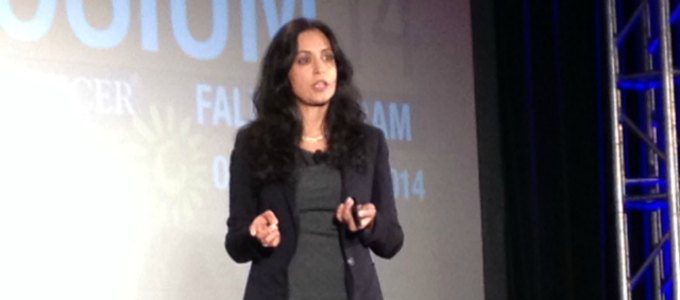The 2014 Fall CLO Symposium started off on a high note, even if it wasn’t quite in tune.
The unofficial kickoff to the festivities began Sunday night at the Park Hyatt Aviara in Carlsbad, California, with a ceremony recognizing this year’s Learning in Practice awards winners. Along with numerous other awards, PwC’s Chief Learning Officer Tom Evans took home top honors as this year’s CLO of the Year.
The event was immediately followed by what will hopefully become a new symposium tradition: CLO-ke, Chief Learning Officer magazine’s live-band karaoke. Words alone don’t do justice to Editor-In-Chief Mike Prokopeak’s rendition of the Marvin Gaye classic, “Let’s Get It On.” You just had to be there.
After dancing and singing the night away, the symposium opened Monday with a keynote address from Shaifali Puri of the Nike Foundation. Puri introduced the event’s theme, exploring new approaches for learning, by discussing the Nike’s efforts to educate impoverished girls through “The Girl Effect.”
The program is built around the concept that girls are the greatest untapped source of human potential. In India, adolescent pregnancy results in nearly $10 billion in lost potential income per year. In Uganda, 85 percent of girls leave school early, resulting in $10 billion in lost potential earnings. By delaying child marriage and early birth for one million girls in Bangladesh, the country could potentially add $69 billion to the national income over these girls' lifetimes.
Created in collaboration with the NoVo Foundation, United Nations Foundation and Coalition for Adolescent Girls, The Girl Effect seeks to include girls in education, health and economic decisions as a means of empowering them to rise above poverty.
But in addition to philanthropy, the program is also an exploration into what it takes to drive human innovation.
Puri spoke of how micro-actions can yield macro-solutions, and they don’t always need to come from traditional sources.
During her presentation, she cited many precursors to Nike’s own effort, including an experiment conducted during her time at PepsiCo Inc. The company offered $10,000 to anyone who could find a more effective way for expectant mothers to get the folic acid they need during pregnancy. While first place went to a scientist from New Zealand, second place went to a journalist and third to the self-titled, “Earth Team,” made up of a collaboration of students from Northwestern University.
The takeaway: “The best ideas don’t always come from likely sources,” Puri said.
Puri connected that advice to the world of human resources by urging attendees to unlock the untapped potential in their own workforces.
Employees need to know that they don’t have to be experts in a given area in order to have a good idea, Puri said. Someone in human resources can solve marketing problems. An employee’s potential is not limited to his or her job description.
Inspired by that message, the participants spent the afternoon first in a panel discussion about finding the right learning delivery method for their organization. Lance Dublin, CEO and chief solution architect of Dublin Consulting, was among the panelists and he made the argument that learning leaders should avoid the distraction of shiny new delivery methods and instead work first to fully understand the problem they are trying to solve within their organization.
From there, technology can be used to solve the problem, and it’s okay to have more than one solution.
The day concluded with a series of workshops, including one on the integration of social and informal learning given by Guitar Center Director of e-Learning at Guitar Center University Chris Salles. Over the past nine months using the Saba cloud platform, Guitar Center has created a knowledge-sharing platform to educate a workforce that doesn’t like traditional learning.
Salles described his sales force as the hard-core music lovers who wanted to drop out of school at 16 to start a band. They don’t want to learn by reading a manual.
With this understanding of his employees, Salles worked with Saba to create a platform that promotes social collaboration by borrowing aspects of traditional social media including the ability to share information, comment and like posts by other employees.
"The only thing our employees like more than being right is telling everyone else about it," Salles said. Guitar Center's learning solution works because it developed from an undertanding of how employees learn and interact on a daily basis.
Keep checking back for more updates over the next two days. Tuesday's schedule includes keynotes from David Epstein, author of "The Sports Gene" and Adam Braun, founder and CEO of Pencils of Promise.















